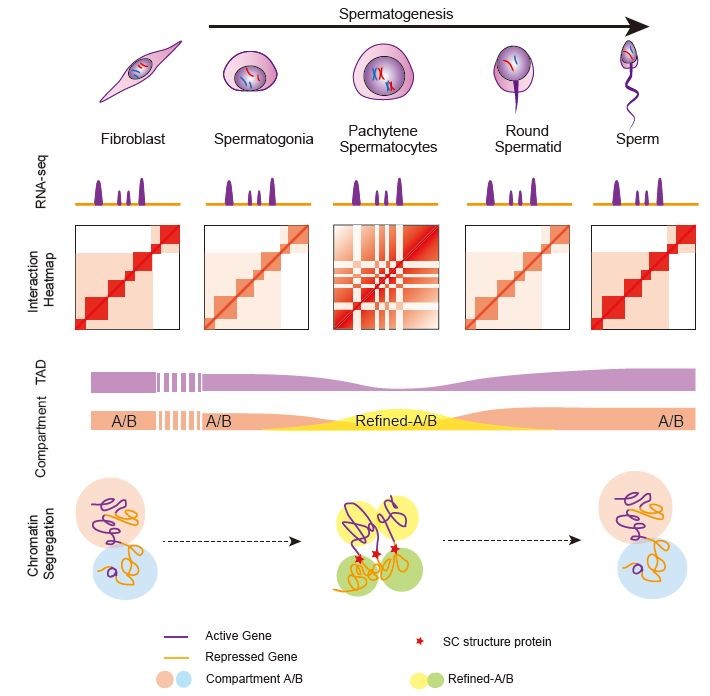Chinese Scientists Reveal the "Reprogramming" of Meiotic Chromatin Architecture during Spermatogenesis

Graphical Abstract. Extensive reprogramming of higher-order meiotic chromatin architecture during mamalian gametogenesis
Prof. Xie Wei of Tsinghua University together with Prof. Wu Xin of Nanjing Medical University, revealed the reprogramming and molecular basis of meiotic chromatin architecture during spermatogenesis in mammals. This project received fundings from the National Outstanding Youth Science Foundation (Grant No. 31725018) and other national science and technology grants. The breakingthrough results were published in the well-known international journal of Molecular Cell, on February 7th, 2019, entitled "Reprogramming of Meiotic Chromatin Architecture during Spermatogenesis".
Hyperlink to the article is as follows, https://doi.org/10.1016/j.molcel.2018.11.019.
In eukocytes, the proper three-dimensional folding of chromatin fiber inside the nucleus is crucial for DNA based biological processes, including gene regulation, DNA replication and cell division. Defects often lead to gene expression disorders and developmental abnormalities. In mammals, new life is initiated by the production and binding of a sperm and an egg and subsequent early embryonic developments. In the process of gametogenesis and pluripotent embryo formation, chromatin undergoes important biological processes, including meiosis, and undergoes a series of significant chromatin recombination. Unfortunately, due to the limitations of technologies, little is known on its process, molecular mechanism and functions.
In recent years, with the help of high-throughput sequencing chromosome conformation capture (Hi-C) and other chromatin three-dimensional architecture techniques, researchers have successfully obtained big data on three-dimensional architecture of various types of cells in many species. With the development of highly sensitive chromatin conformation detection technology, Prof. Xie’s team has been able to demonstrate that mammals have unique three-dimensional chromatin architecture and reprogramming mode after fertilization, and extensive reprogramming occurs during early embryonic development (Nature, 2017; Nature Genetics, 2018). However, the underlying mechanism of the three-dimensional chromatin folding and reprogramming at the molecular level still remains unknown.
Taking the advantage of the microcell three-dimensional genome detection technique sisHiC, developed by the research team, they examined spermatogonia, pachytene spermatocytes, round spermatocytes and mature sperms during spermatogenesis in primates (rhesus monkeys). The results showed that during spermatogenesis, topologically associating domains (TADs) undergo dissolution and reestablishment in spermatogenesis. Researchers also reported that highly refined local compartments that alternated between transcribing and non-transcribing regions (refined A/B). During this period, homologous chromosomes synapse to form synaptic complexes, resulting in homologous recombination. Studies in mice suggest that the refined A/B is conservative and can not be eliminated by transcriptional inhibition experiments. if synaptonemal complex structural protein Sycp2 and Top6bl of DNA topisomerase were mutated in spermatocytes, the refined compartment structure could not be established normally, while the TADs could be partially restored. These results reveal the molecular basis of synaptic complex inhibiting TADs and promoting the formation of refined compartment structure.
This study is, for the first time, delineated the three-dimensional architecture of meiotic chromatin during gametogenesis at the molecular level. It will not only extend our knowledge on the condensation process of the meiotic chromatin architecture during gametogenesis, but also help us further understand the molecular basis of homologous chromosome pairing and recombination in meiosis.
Contact Us

National Natural Science Foundation of China
Add: 83 Shuangqing Rd., Haidian District, Beijing, China
Postcode: 100085
Tel: 86-10-62327001
Fax: 86-10-62327004
E-mail: bic@nsfc.gov.cn
